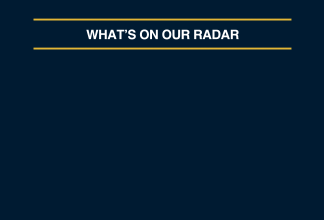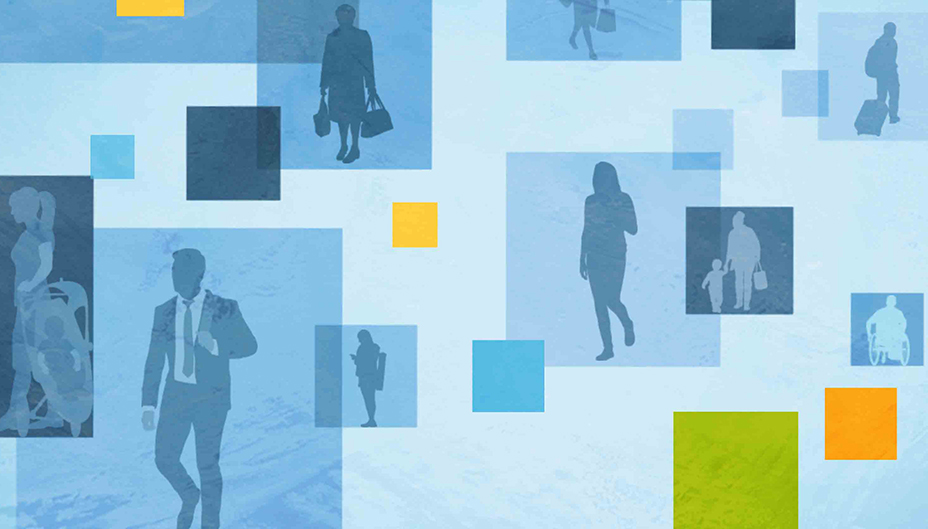Report: 8 Ways COVID Will Change the Economy and Disrupt Businesses
Written by The Content Team
Published on June 1, 2020
minute read
Share:
Working from home, shopping online and binge watching like never before - how we work, shop and watch has seen major changes due to COVID-19, as has the way we share, travel, heal, learn and trade. In its After the Crisis report below, RBC Thought Leadership summarizes the shifts it's seen in these eight areas and offers a snapshot of what they could mean for investors.
2. How we shop
More shipping, more local, more expensive
What we're seeing
- Nearly 3 in 10 Canadians are now shopping online for things they normally would have bought in a store.
- 70% of Americans expect to avoid some public spaces after the lockdowns ease.
- More than half say they expect to stay away from shopping malls.
- Roughly 1/3 expect to stay away for more than six months.
- "Buy local" has become a clarion call: 78% of Canadians are more likely to choose Canadian brands/products as a result of the pandemic.
What this means
- Traditional brick and mortar business models, including malls, will be challenged while social distancing measures are in place.
- Digitally-enabled retailers can capture more customers outside their home base.
- Realignment of value chains. Fewer aircraft, less international shipping, more local supplies, potentially higher prices due to lost efficiencies.
UP
- E-commerce platforms and aggregators.
- Businesses pivoting to online services, such as online orders for delivery and pick-up.
- High quality local providers.
DOWN
- Department stores.
- Secondary and tertiary malls.
- Commercial property owners.
3. How we watch
More binging, more culture, more global
What we're seeing
- Less money on books and public entertainment and more on home entertainment.
- Amazon's Twitch users streamed 50% more hours between March and April, and a full 101% jump year over year. Users are now watching up to 1.6 billion hours per month.
- Netflix added 16 million subscribers in Q1.
- Collapse of live events has led to a surge in virtual competitions.
- E-sports audience estimated to be 500 million people in 2020.
- Verizon saw a 75% increase in gaming after the quarantine took effect.
- 43% won't go to arena, stadium or concert venue until there's a vaccine.
- In-person arts and culture purveyors saw a spike in online traffic
- British Museum went from 2,000 daily online visits to 75,000.
- Louvre Museum site traffic increased 10-fold.
- Vancouver Symphony Orchestra received more than 120,000 views for recent virtual performances.
What this means
- Arts and culture providers will need to find creative ways to deliver entertainment to consumers, rather than expect them to leave their homes.
- Consumer spending on augmented reality and virtual reality (AR/VR) is expected to be $7 billion in 2020. AR/VR headsets projected to grow 23.6% in 2020, and grow 10-fold over 5 years.
- Professional leagues and teams will need to accelerate their "augmentation" strategies through gaming and streaming, including from fan-less venues.
- Content creators need to work with platforms to build global audiences.
UP
- Streaming services.
- Star performers and athletes to build global followings.
- Challenger teams and leagues to create global markets.
DOWN
- Museums, art galleries.
- Sports arenas.
- Cinemas.
4. How we share
More bandwidth, more data, more hacks
What we're seeing
- Big increases in cross-border data flows.
- Data creation will grow to 175 zettabytes (ZB) by 2025, 10 times the amount of data produced in 2017.
- Individuals are expected to interact with a connected device 4,800 times a day (300 times per waking hour, or 5 times per minute).
- Big Tech getting bigger
- Market cap of the Big Six U.S. tech companies was close to $5 trillion in early May, up ~20% in the crisis.
- More cyber hacks
- WHO experienced a 5-fold increase in cyberattacks since the start of the pandemic.
- Since 2013, records are stolen from breaches at a rate of 44 per second.
- Active phishing sites went up by 350% between January and March.
What this means
- Greater demand for companies that transmit and store data safely.
- Alibaba plans to invest US$28 billion into cloud business over next 3 years.
- Big investments in bandwidth for regions and centres, and shared buildings.
- More flexible approaches to privacy to balance safeguards against new and existing threats and the need for health security.
UP
- Big Data vendors.
- AI cybersecurity.
- Distributed software protection.
DOWN
- Breachable, data-rich organizations.
- Firms without scale or culture to analyze data for market advantage.
5. How we travel
More local, more modest, more active
What we're seeing
- 68% unlikely to take a vacation in 2020.
- Once pandemic has ended:
- 63% prefer to drive than fly, and 62% prefer to stay in Canada.
- Only 32% willing to stay at a hotel or resort, and 10% to take a cruise.
- Canadians significantly less likely to travel to other provinces. Net intention remains negative.
What this means
- Slow and tiny distributed recovery to tourism, with more road-based vacations to smaller centres.
- Decline of festivals, events and major attractions.
- More desire for localized adventure and experience.
UP
- Car rentals and audio tours.
- High-end destinations within driving distance of major population centres.
- Curated wilderness experiences and mixed offerings like agri-tourism.
DOWN
- Large hotels, cruise liners.
- High volume destinations like theme parks and beach resorts.
- Border communities reliant on international travellers.
6. How we heal
More protection, more screening, more expensive
What we're seeing
- Contact tracing technologies modelled after South Korea and Singapore.
- 3 out of 4 Canadians said they won't feel safe until a treatment or vaccine is available.
- Screening technology such as thermal cameras in airports and train stations, as well as hospitals, clinics and possibly schools.
- "Active aging" industry in the U.S. is expected to triple in the next 3 years to $30 billion.
What this means
- Mass shift to remote health care through video-consultations.
- Centralization of clinics for digital capacity and 24/7 service, with field teams to serve WFH population and isolated seniors.
- More advanced tech in seniors' homes due to worker shortages.
- Canadian government spending on elderly benefits will triple by 2030 from $35 billion spent in 2010.
UP
- Smart-living technologies.
- Biotech companies specializing in biometrics. Facial recognition technology, infrared body scanners.
- Contact tracing technologies.
DOWN
- Traditional seniors' communities.
- Businesses without sufficient health and safety protocols for patrons.
- Healthcare providers without a digital-first culture and infrastructure.
7. How we learn
Remote, interactive, personal
What we're seeing
- In March, 1.4 million Canadian post-secondary students shifted to online learning, and many universities now moving to a blended model for the fall term.
- UNESCO estimates nearly 1.6 billion learners worldwide have been affected by school closures, representing 91% of all students.
- In 2019, digital spending was worth 2.5% (or US$142 billion) of all in education expenditures; by 2025, it's expected to reach 4.3% (or US$350 billion).
- Global EdTech investments surpassed US$18.5 billion in 2019, with over half of venture capital activity occurring in China over the last decade.
- The need for reskilling/upskilling will be immense, leading to increase in adult learning. Companies and institutions are beginning to provide experiential learning programs catered to adult learning styles.
- Growth of online platforms usage in crisis:
- Non-profit Khan Academy's site traffic increased 3-fold and users are spending twice the amount of time.
- Canada's largest online-only school, Athabasca University, saw April enrolment grow by 12.3% for undergraduates and by 10.7% for graduate studies.
What this means
- Universities and colleges will spend more on technology infrastructure.
- Traditional course design and pedagogy will turn to alternative delivery methods, as past resistance of faculty to online learning has been side-stepped.
- More blended learning with hybrids of online and face-to-face models.
UP
- Menu-based degrees, with greater student choice and sharing between schools.
- Integration of micro-learning as partial credit within programs.
- Digital internships and other forms of work-integrated learning.
DOWN
- Schools with weak digital teaching cultures, or the scale to invest in digital and data capabilities.
- International student enrolment – currently nearly 500,000 post-secondary learners.
- Employers that don't provide high-touch experiential learning through digital channels, losing access to best talent.
8. How we trade
More protectionism, fewer imports, higher prices
What we're seeing
- Protectionism growing in political importance, largely for offensive positioning:
- The World Trade Organization identified more than 100 protectionist measures in place.
- Japan offering incentives to repatriate factory production.
- Korea, Taiwan protecting IP rights in semi-conductors and other tech.
- Countries like Serbia, Morocco, Kazakhstan have sought to limit exports of critical food staples, such as wheat and rice.
- India has banned the export of "key" medicines.
- Saskatchewan, B.C. and Quebec launched marketing campaigns to promote local purchases.
- Baltic Dry Index – a key measure of international trade – is down 2/3 since December and down 80% since last summer.
What this means
- Countries re-evaluating economic security and restructuring supply chains, with more talk of economic nationalism.
- Shift to strategic stimulus may lead to more aggressive steps, including procurement restrictions.
- Consumers to eventually face higher prices and less selection.
UP
- Strategic procurement.
- Bilateral and regional trade agreements.
- Higher value exports such as specialized food.
DOWN
- Canadian firms relying on procurement in other countries.
- Low-margin producers that lack scale.
- Low-income and remote populations.
RBC Direct Investing Inc. and Royal Bank of Canada are separate corporate entities which are affiliated. RBC Direct Investing Inc. is a wholly owned subsidiary of Royal Bank of Canada and is a Member of the Canadian Investment Regulatory Organization and the Canadian Investor Protection Fund. Royal Bank of Canada and certain of its issuers are related to RBC Direct Investing Inc. RBC Direct Investing Inc. does not provide investment advice or recommendations regarding the purchase or sale of any securities. Investors are responsible for their own investment decisions. RBC Direct Investing is a business name used by RBC Direct Investing Inc. ® / ™ Trademark(s) of Royal Bank of Canada. RBC and Royal Bank are registered trademarks of Royal Bank of Canada. Used under licence.
© Royal Bank of Canada 2025.
Any information, opinions or views provided in this document, including hyperlinks to the RBC Direct Investing Inc. website or the websites of its affiliates or third parties, are for your general information only, and are not intended to provide legal, investment, financial, accounting, tax or other professional advice. While information presented is believed to be factual and current, its accuracy is not guaranteed and it should not be regarded as a complete analysis of the subjects discussed. All expressions of opinion reflect the judgment of the author(s) as of the date of publication and are subject to change. No endorsement of any third parties or their advice, opinions, information, products or services is expressly given or implied by RBC Direct Investing Inc. or its affiliates. You should consult with your advisor before taking any action based upon the information contained in this document.
Furthermore, the products, services and securities referred to in this publication are only available in Canada and other jurisdictions where they may be legally offered for sale. Information available on the RBC Direct Investing website is intended for access by residents of Canada only, and should not be accessed from any jurisdiction outside Canada.
Explore More

Here’s What Every Canadian Should Know About Estate Planning
Insights from Leanne Kaufman to help you feel more confident as you plan
minute read

3 Things We're Watching This Week
What the Inspired Investor team is watching
minute read

What’s Driving the Recent Surge in Gold Prices
Here are some things to watch with the gold market
minute read
Inspired Investor brings you personal stories, timely information and expert insights to empower your investment decisions. Visit About Us to find out more.








_______________________________________________________________________________________
8 Ways COVID Will Transform the Economy and Disrupt Every Business
By John Stackhouse
If there is one lesson from the pandemic of 2020, it may be this: We are biological beings in a digital age.
No matter how much technology we have, we've discovered we cannot escape nature's grip. And yet, no matter how humbling this crisis has been, it also should remind us that even a massive jolt to the planet cannot change the trajectory of the Fourth Industrial Revolution. If anything, we're emerging from this crisis with an even greater desire to harness smart technologies, new forms of intelligence and vast pools of data to transform pretty much everything we do. COVID did not crush the future. It merely brought it forward.
In the short term, the economic recovery won't be as fast as the consumer and social changes that are hitting every business and community. The scar tissue will take time to heal. We expect the Canadian economy, as measured by GDP, to decline 5.5% for 2020, as international trade limps along, unemployment lingers in the double-digits and consumers stay home, literally and figuratively. Even as provinces allow for businesses, community groups and eventually schools to reopen, a quiet nervousness will give the economy a collective pause, and people everywhere will focus anew on income security and health security.
This new age of insecurity will do more than pervade the Canadian psyche. We estimate that even with a modest recovery, which won't fully get going until 2022, the combined loss of economic output for Canada may exceed $1 trillion. The setback is already holding back investors and entrepreneurs, and may also give government leaders pause as they allocate unprecedented sums to kick-start an economy that may be reluctant to rev. Our regular tracking of small- and medium-sized business owners shows caution across the board: three-quarters have partially or fully closed, and a third have laid off staff. More worrisome, a quarter are not very confident they'll make it. And while one in five Canadians feel they're “sinking" economically, small business owners are twice as likely to hold that sentiment.
Who will be first back in the water is always a tough question, but that's when the pearls of opportunity are most plentiful. Yes, the novel coronavirus of 2019 has unleashed a massive global recession – but it's also unleashing waves of innovation as we all change the way we work, shop, eat and travel. And companies, old and new, that are watching this sudden sea change in human behaviour are starting to grow like never before.
In this report, we look at eight major trends underway in the world, and pinpoint the possibilities for savvy business operators, investors and innovators. We all know how much our lives have changed, and how we're not likely to go back to our old ways. We'll be more cautious but we also may be more creative. As history likes to remind us, with unprecedented times come unprecedented opportunities.
1. How we work
Fewer offices, less paper, more productivity
What we're seeing
What this means
UP
DOWN